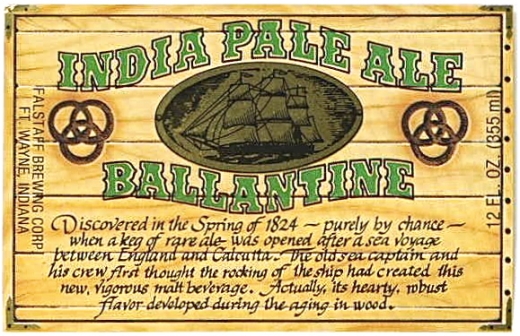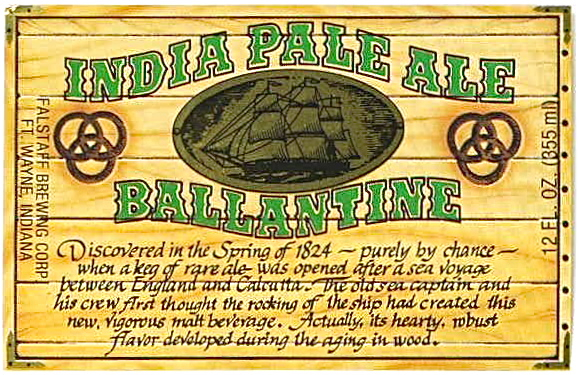With the recent news that the Pabst Brewing Co. was resurrecting the old Ballantine India Pale Ale (or a version of it, at least), I thought it was a good time to chronicle the most influential examples of what’s become one of the most popular craft beer styles on the planet: the American-born IPA (not to be confused with the American IPA style iteration itself). Let’s start in the way-back machine.
Ballantine IPA
The old Ballantine IPA, born in the 1870s, was the only pre-Prohibition American example of the style to survive into the last few decades of the 20th century. It gradually disappeared from shelves and taps in the 1970s, shortly after the company itself entered a terminal decline. (Pabst has owned the Ballantine brand since 2005.)
Several huge figures in American craft beer, most notably Ken Grossman at the Sierra Nevada Brewing Co., have cited Ballantine IPA as a major influence, not just on their own tastes but on the many iterations of IPA in the United States that came after it.
Anchor Liberty Ale
By the time the sun was setting on Ballantine IPA, it was rising, however slowly, on a new beer from the tiny Anchor Brewing Co. in San Francisco. I’ve told the story of Liberty Ale before, most recently in a column for All About Beer magazine.
The crux of it is this: The ale, first brewed in early 1975 to commemorate the 200th anniversary of Paul Revere’s ride through Greater Boston (hence the name), was the first craft beer to use the relatively new U.S.-developed Cascade hops commercially. That hop gave Liberty Ale a citrusy, almost grassy aroma and contributed mightily to a pleasingly bitter taste—the basic benchmarks of any modern American-born IPA. Though Anchor did not label it an IPA (the term was not in vogue), Liberty Ale can be seen as the urtext for the style in American craft beer.
Sierra Nevada Pale Ale
Speaking of IPAs that don’t go by the name, there is no denying the contribution of Sierra Nevada’s iconic pale ale to the genre. Iconic why? With its own liberal dosing of Cascade hops and (reportedly) yeast cultured from Ballantine IPA, Sierra Nevada Pale Ale when it dropped in early 1981 was far bitterer than most domestically made beers that were commercially available.
For better or for worse, it spawned the supposed West Coast style of IPA: big, bold and strong alcohol-wise. Like Anchor Liberty Ale, though, Sierra Nevada Pale Ale seems rather mild stacked against the IPAs it inspired.
Lagunitas IPA
The Lagunitas Brewing Co. was the first California brewery to lead with an IPA (in name and style). Amazing, right? In an era when IPAs are de rigueur for new craft breweries, especially those on the West Coast, Lagunitas founder Tony Magee’s 1995 decision was as striking as the IPA he put out.
Originally conceived as a seasonal and clearly inspired by the likes of Liberty Ale and Sierra Nevada Pale Ale, Lagunitas IPA was a meatier (read: hoppier) version of either—stronger, too, at 6.2 percent alcohol by volume, whereas neither Liberty nor Pale Ale topped (or top) out at more than 6 percent.
Blind Pig Inaugural Ale
Around the same time Lagunitas was brewing its signature IPA, a young brewer named Vinnie Cilurzo was conjuring up a strong, bitter ale for a Temecula, Calif., brewpub he co-owned called the Blind Pig. Aware that he was working with antiquated equipment acquired from a man named Dave “Electric Dave” Harvan, one of Arizona’s craft beer pioneers, and that such equipment might foment off-flavors, Cilurzo in the spring of 1994 went heavy on the hops. The idea was that the hops might cover up anything seriously wrong with the finished product.
From that decision sprang what is widely regarded as the first double IPA in the U.S.: Blind Pig Inaugural Ale (not to be confused with Blind Pig IPA, another beer created by Cilurzo, who would go on to great acclaim as co-proprietor and brewmaster at the Russian River Brewing Co. in Santa Rosa, Calif.). The frenetically bitter Inaugural Ale, along with Lagunitas IPA, birthed the extreme offshoot of the American genus of IPA: your double, triple, quadruple, Belgian-style, red, black, etc., IPAs.
They were very different than Ballantine, Liberty and Sierra Nevada, but equally influential.
· Ballantine IPA To Return [Brookston Beer Bulletin]
· Brewing Up History: Ballantine IPA a la Today [Beer Stained Letter]
· Hold It, Which Blind Pig Beer Was One of the First Double IPAs? [Appellation Beer]
· A Bitter Beginning: The First Anchor Liberty Ale Bottles [All About Beer]


Very nice. But the graphic you used for the Ballantine India is the corny label they slapped on the product during its sad decline before it finally disappeared. Why not use the classic foil label that was on the bottles during the years when it was a true craft product? That label had dignity worthy of the brew.
Other than that, love the page and the site.
Keep on keepin’ on…